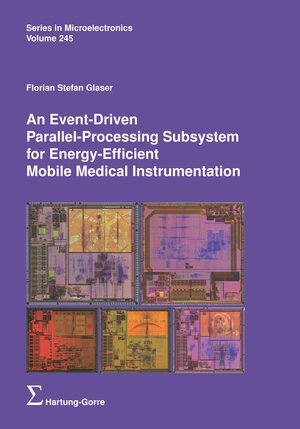An Event-Driven Parallel-Processing Subsystem for Energy-Efficient Mobile Medical Instrumentation
von Florian Stefan Glaser, herausgegeben von Luca Benini und weiterenAging population and the thereby ever-rising cost of health services call for novel and innovative solutions for providing medical care and services. So far, medical care is primarily provided in the form of time-consuming in-person appointments with trained personnel and expensive, stationary instrumentation equipment. As for many current and past challenges, the advances in microelectronics are a crucial enabler and offer a plethora of opportunities. With key building blocks such as sensing, processing, and communication systems and circuits getting smaller, cheaper, and more energy-efficient, personal and wearable or even implantable point-of-care devices with medicalgrade instrumentation capabilities become feasible. Device size and battery lifetime are paramount for the realization of such devices. Besides integrating the required functionality into as few individual microelectronic components as possible, the energy efficiency of such is crucial to reduce battery size, usually being the dominant contributor to overall device size.
In this thesis, we present two major contributions to achieve the discussed goals in the context of miniaturized medical instrumentation: First, we present a synchronization solution for embedded, parallel near-threshold computing (NTC), a promising concept for enabling the required processing capabilities with an energy efficiency that is suitable for highly mobile devices with very limited battery capacity. Our proposed solution aims at increasing energy efficiency and performance for parallel NTC clusters by maximizing the effective utilization of the available cores under parallel workloads. We describe a hardware unit that enables fine-grain parallelization by greatly optimizing and accelerating core-to-core synchronization and communication and analyze the impact of those mechanisms on the overall performance and energy efficiency of an eight-core cluster. With a range of digital signal processing (DSP) applications typical for the targeted systems, the proposed hardware unit improves performance by up to 92% and 23% on average and energy efficiency by up to 98% and 39% on average.
In the second part, we present a MCU processing and control subsystem (MPCS) for the integration into VivoSoC, a highly versatile single-chip solution for mobile medical instrumentation. In addition to the MPCS, it includes a multitude of analog front-ends (AFEs) and a multi-channel power management IC (PMIC) for voltage conversion. The MPCS is comprised of a highly capable single-core control and peripheral MCU subsystem and a quad-core cluster which achieves a peak energy efficiency of 31GOPS/W at 0.48V and also features our synchronization solution. We extend the single-core MCU subsystem with a range of application-specific hardware units that – together with a sophisticated event-based power management scheme – allows the subsystem to operate in a wide range of low power modes. We achieve autonomous AFE readout, buffering, and light processing operation without the interaction of any core at 25.3 μW and a standby power consumption of less than 10 μW with 16 kB of retentive memory. On the other end of the spectrum of power modes, all cores of the MPCS combined achieve a peak performance of 581 MOPS.
In this thesis, we present two major contributions to achieve the discussed goals in the context of miniaturized medical instrumentation: First, we present a synchronization solution for embedded, parallel near-threshold computing (NTC), a promising concept for enabling the required processing capabilities with an energy efficiency that is suitable for highly mobile devices with very limited battery capacity. Our proposed solution aims at increasing energy efficiency and performance for parallel NTC clusters by maximizing the effective utilization of the available cores under parallel workloads. We describe a hardware unit that enables fine-grain parallelization by greatly optimizing and accelerating core-to-core synchronization and communication and analyze the impact of those mechanisms on the overall performance and energy efficiency of an eight-core cluster. With a range of digital signal processing (DSP) applications typical for the targeted systems, the proposed hardware unit improves performance by up to 92% and 23% on average and energy efficiency by up to 98% and 39% on average.
In the second part, we present a MCU processing and control subsystem (MPCS) for the integration into VivoSoC, a highly versatile single-chip solution for mobile medical instrumentation. In addition to the MPCS, it includes a multitude of analog front-ends (AFEs) and a multi-channel power management IC (PMIC) for voltage conversion. The MPCS is comprised of a highly capable single-core control and peripheral MCU subsystem and a quad-core cluster which achieves a peak energy efficiency of 31GOPS/W at 0.48V and also features our synchronization solution. We extend the single-core MCU subsystem with a range of application-specific hardware units that – together with a sophisticated event-based power management scheme – allows the subsystem to operate in a wide range of low power modes. We achieve autonomous AFE readout, buffering, and light processing operation without the interaction of any core at 25.3 μW and a standby power consumption of less than 10 μW with 16 kB of retentive memory. On the other end of the spectrum of power modes, all cores of the MPCS combined achieve a peak performance of 581 MOPS.






